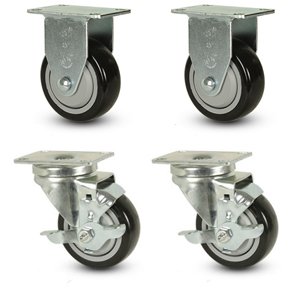
Toolbox Caster Set
Casters are essential components used in various applications to facilitate the movement of heavy objects. Whether used in industrial settings, office environments, or at home, casters play a crucial role in enhancing mobility and reducing the effort required to move items. In this guide, we will explore the mechanics of casters, their types, and their applications.
What Are Casters?
Casters are wheels that are mounted to the bottom of a larger object, enabling it to roll. They consist of several components, including the wheel itself, a mounting frame known as the caster bracket or rig, and a bearing that allows the wheel to rotate. Casters can be attached to a variety of objects, such as carts, chairs, racks, and machinery.
Types of Casters
There are several types of casters, each designed for specific applications:
1. Rigid Casters
Rigid casters, also known as fixed casters, have a fixed wheel orientation. This means they can only move forward and backward, providing excellent stability and control for heavy loads. However, they do not offer the flexibility to turn corners easily.
2. Swivel Casters
Swivel casters are designed with a rotating bearing above the wheel, allowing the wheel to rotate 360 degrees. This enables the object to be moved in any direction, making it easy to maneuver around obstacles and corners. Swivel casters are commonly used in applications where flexibility and ease of movement are essential.
3. Brake Casters
Brake casters come with a braking mechanism that can lock the wheel in place, preventing it from moving. This feature is particularly useful in situations where stability is crucial, such as on sloped surfaces or during loading and unloading operations. Brake casters can be either rigid or swivel.
4. Specialty Casters
There are various specialty casters designed for specific needs, such as heavy-duty casters for industrial equipment, medical casters for hospital beds, and low-profile casters for furniture. Each type of specialty caster is engineered to meet the unique requirements of its application.
How Do Casters Work?
The operation of casters involves several mechanical principles:
1. Load Distribution
Casters distribute the weight of the object they are attached to across the wheels, reducing the force needed to move the object. The load capacity of a caster is a critical factor, as exceeding this capacity can cause the caster to fail.
2. Wheel Rotation
The wheel of a caster rotates around an axle, allowing it to roll along the ground. Bearings within the wheel reduce friction and enable smooth movement. The type of bearing used can affect the performance of the caster, with options including ball bearings, roller bearings, and plain bearings.
3. Swivel Mechanism
In swivel casters, a swivel bearing allows the wheel to rotate around a vertical axis. This rotation provides the caster with the ability to change direction easily. The design of the swivel mechanism, including the type of bearing and the placement of the pivot point, impacts the caster’s maneuverability and stability.
4. Braking System
Brake casters feature a mechanism that can lock the wheel or the swivel, or both. The braking system is typically engaged manually, using a pedal or lever. This prevents unwanted movement, ensuring that the object remains stationary when needed.
Applications of Casters
Casters are used in a wide range of applications across different industries:
1. Industrial and Manufacturing
In industrial settings, casters are used on machinery, carts, and racks to facilitate the movement of heavy equipment and materials. Heavy-duty casters are essential in these environments to handle substantial loads and withstand harsh conditions.
2. Medical and Healthcare
Medical casters are found on hospital beds, medical equipment, and furniture. These casters are designed for smooth, quiet operation and often include features like braking systems and antimicrobial coatings to ensure safety and hygiene.
3. Office and Furniture
Office chairs, desks, and other furniture often use casters to allow for easy repositioning and flexibility in office layouts. Low-profile casters are commonly used to maintain a sleek appearance while providing mobility.
4. Retail and Hospitality
In retail and hospitality settings, casters are used on display racks, trolleys, and equipment carts to facilitate quick and efficient movement. The ability to easily rearrange layouts and transport items is crucial in these fast-paced environments.
Conclusion
Casters are versatile components that play a vital role in improving mobility and efficiency across various applications. Understanding the different types of casters and their mechanisms can help in selecting the right caster for a specific need, ensuring optimal performance and durability.

